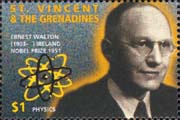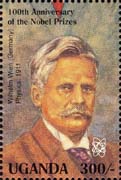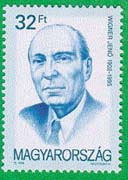|
|
Physicist / Astronomer Stamps
|
W

1910 Nobel Physics prize for his work on the equation of state for gases and liquids. Dutch scientist. Born November 23, 1837 in Leiden, Netherlands. He was known for his theory of binary solutions and the thermodynamic theory of capillarity. He died March 9, 1923 in Amsterdam. Stamps Netherlands. - Maldives MIS1995L28.46 Sweden 879; 882
English mathematician, author, poet, astronomer, journalist. Born around 1734 he became well-known for his contributions to the Ladies Diary, a magazine which concerned itself with advanced mathematical problems. The Royal Society sent him in 1769 to the northwest coast of the Hudson Bay to observe the transit of Venus, and the results of his researches were published in 1772 under the title, General Observations made at Hudson Bay. In 1772 he was selected by the noted English captain and explorer, James Cook, to carry on astronomical observations during the Cook's second voyage around the world. He returned to England in 1774 and two years later he published in his book, Observations on a Voyage With Captain Cook. He sailed with Captain Cook in 1776 on the expedition in which Captain Cook was slain in Hawaii. During the later years of his life he held the chair of mathematics at Christ's Hospital. He died in London on December 29, 1798. He was the author of the following books: Astronomical Observations made during the Voyages of Byron, Wallis, Carteret, and Cook, London, 1788; and A Voyage towards the North Pole, London, 1774.- New Hebrides (Br.) 190 New Hebrides (Fr.) 209

1951 Nobel Physics prize for pioneer work on the transmutation of atomic nuclei by artificially accelerated atomic particles. He was born October 6, 1903 in Durgorvan, Ireland. Walton was born on 6 October 1903 in Dungarvan, Co Waterford, Ireland. His father was a Methodist minister, so the family frequently moved around Ireland from one manse (an ecclesiastical residence) to the next. Methodist College, Belfast, provided his secondary education. He took the BA and MSc degrees in Trinity College, Dublin, where his research was in hydrodynamics. John Joly, whose achievements also involved the alpha particle, recommended him to Rutherford, under whose supervision he received a PhD in 1931. Based in Cambridge's Trinity College, he was funded initially by an 1851 Exhibition Overseas Research Scholarship. After his PhD he stayed on until 1934 in the Cavendish Laboratory as Clerk Maxwell Scholar. Before his momentous collaboration with Cockcroft, Walton worked on attempting to accelerate electrons in a circular electric field, starting from ideas of Rutherford and J J Thomson. This effort was a basis for the subsequent development by Kerst in the USA of the betatron. Following earlier work of Wideroe, he then tried to build a linear accelerator for positive ions. Walton also used the 1932 accelerator with Cockcroft to bombard a range of targets other than lithium, and to accelerate deuterons derived from a sample containing the newly discovered deuterium. The enormous media publicity accorded to the 1932 breakthrough was in contrast to that received by James Chadwick when he discovered the neutron just two months earlier in the Cavendish. Nuclear energy, it was reported in the Reynolds News, implied 'nothing less than the complete abolition of irksome manual labour and a new era of prosperity for all'. By a striking coincidence the very issue of The Times which announced the work also reviewed a newly opened West End play, Wings over Europe, in which a scientist disintegrated and transmuted matter with nuclear energy, as a result of which the end of the world was threatened. Walton must have winced at this juxtaposition. A pacifist, he was always at pains to stress that he did not feel in some way responsible for the subsequent development of nuclear weapons. These relied on two things, neither of which, as he said, was attributable to him: the fission of very heavy nuclei such as uranium, and the chain reaction of the resulting neutrons. After the annus mirabilis many of Rutherford's team in the Cavendish dispersed around the world. Walton could have gone to laboratories in the USA or elsewhere. Instead he returned to Dublin, and in 1934 was elected to fellowship of Trinity College. In 1947 he also became head of physics and the Erasmus Smith's Professor. Walton's heavy teaching and administrative duties in an impoverished college were in complete contrast to his Cambridge career. He worked on designing and building another accelerator as best as he could, and was involved in various scientific projects connected with alleviating the hardship of the war years. He never wished to be singled out for special support. Nor was it in his nature to be attracted by opportunities elsewhere. He certainly had no wish to accept Chadwick's invitation to join a 'secret project' in the States, which turned out to be the Manhattan project to develop a nuclear bomb. When better times arrived for the support of science in Ireland, he rejoiced in the relative abundance enjoyed by his successors, without showing a trace of regret. He gained special satisfaction from the excellence of his teaching over several decades. Even in his late seventies, he gave demonstration lectures which were models of simplicity, clarity and integrity. They were a revelation to those who were privileged to see their effect upon a youthful audience. He also continued to lecture about his life's work, returning for example in 1982 to Cambridge to give a memorable contribution to the Institute of Physics conference on the 50th anniversary of the discovery of the neutron. Following his retirement in 1974, he retained his association with the Physics Department at Trinity up to his final illness. His was a familiar face in the tea-room. Visitors, on being introduced to the quiet, unassuming man in the corner, softly whistling a hymn or a Percy French melody, would be astonished to find that he was one of the great figures of the history of physics. Shortly before his death he marked his lifelong devotion to Trinity by presenting his Nobel medal and citation to the college. Walton's life was governed by unshakeable principles, a conviction derived from his steadfast Methodist faith. He was President of the Irish Pugwash Group, concerned with reducing the dangers of nuclear war. In November 1994 the President of the Republic of Ireland, Mary Robinson, paid him a special visit in his Belfast nursing home to honour him as a man of science and a man of peace. Having attained the summit of his early ambition, he led a long and contented life, and inspired several generations of physicists. His four children, Alan, Marion, Philip, and Jean, are all scientists, the first three being physicists - though not, as he emphasised, through any pressure from him.
1960 Nobel Physics prize for contributions to the theory of the unified weak and electromagnetic interaction between elementary particles, including, inter alia, the prediction of the weak neutral current
American astronomer. Stamp Mauritania 622
2001 Nobel Physics prize for the achievement of Bose-Einstein condensation in dilute gases of alkali atoms, and for early fundamental studies of the properties of the condensates

Born: 17 Nov 1902 in Budapest, Hungary
Died: 1 Jan 1995 in Princeton, New Jersey, USA

1963 Nobel Physics prize for his contributions to the theory of the atomic nucleus and the elementary particles, particularly through the discovery and application of fundamental symmetry principles. Eugene P. Wigner (1902 - 1995) was awarded the Nobel Prize in Physics in 1963, shared with Maria Goeppert-Mayer (1906-1972) and Hans Daniel Jensen (1907 - 1973) “for his contributions to the theory of the atomic nucleus and the elementary particles, particularly through the discovery and application of fundamental symmetry principles”.
Eugene P. Wigner pursued his grammar school studies in the famous Fasor evangelic grammar school in Budapest and gained admission to the University of Berlin to become a chemical engineer according to the wishes of his father. In the twenties, Berlin was the acropolis of modern physics. Wigner also attended the classes and seminars of Albert Einstein (1879 - 1955), Max Planck (1858 - 1947), Max von Laue (1879 - 1960). In Berlin, he prepared his doctoral thesis under the leadership of Michael Polanyi (1891 - 1976), which was a pioneering work in quantum-chemistry.
Having completed his university studies in Berlin, he came home to utilize his qualification in his father's leather factory. When he became informed that Werner Heisenberg (1901 - 1976) and Max Born (1882 - 1970) developed the quantum mechanics, he returned to Berlin. With the help of his old teacher, Michael Polanyi, he joined the Kaiser Wilhelm Institute where he faced the problem: why do the atoms &ldquolike” to sit in the symmetry planes and at symmetry points of the crystal. Starting from this, he was the first to realize that space-time symmetries play a central role in quantum mechanics. In his book entitled Group theory method in quantum mechanics, he showed that all the significant exact results of quantum mechanics can be achieved through the symmetry groups. This is also emphasized in the reasoning of the Nobel Prize awarded in 1963.
In the thirties, Wigner accepted an overseas invitation and from this time onward, he worked at Princeton University, for six decades. During World War II, he played an outstanding part in starting the atomic age and, after the War, in the peaceful and safe utilization of nuclear energy. It can be say that he was the first reactor engineer in the world. When he died, the New York Times commemorated in a five-column article “the man who introduced mankind to the atomic age and had the courage to re-tailor the science of sub-atomic particles”. “He was one of those scientists endowed with remarkable imagination and foresight who were born and who studied in Budapest and came to the West to alter the modern world.”
Biography

1927 Nobel Physics prize for his method of making the paths of electrically charged particles visible by condensation of vapour. 14. 2. 1869- C.T.R. Wilson, inventor of the cloud chamber (with which nuclear phenomena have been explored and Nobel prizes been won), is born the son of a shepherd in Glencorse, Scotland.
|
|




